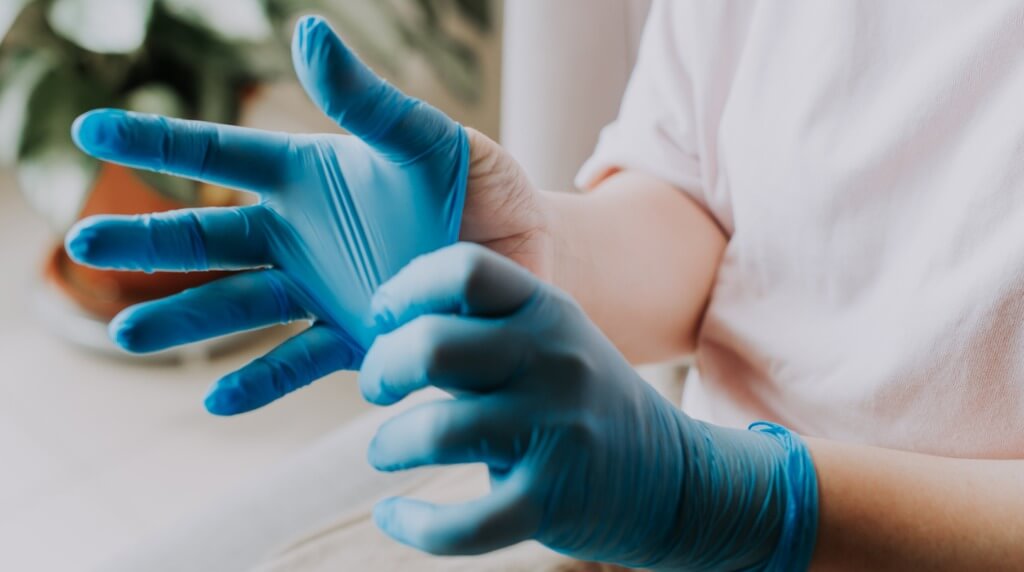Von Handschuhen zu Bänken: Recycling von Kunststoffen zur Verbesserung der Nachhaltigkeit in der Biotechnologie

In building towards a greener future, Twist Bioscience has built sustainability into its DNA synthesis platform. Through miniaturized chemistry, Twist enables massive scaling of the DNA synthesis process while also greatly reducing the company’s chemical footprint. But, to truly work towards a sustainable future, laboratories have to go beyond their products to address the challenge of sustainable science.
Labs churn through single-use plastics at an astonishing rate. Back-of-the-envelope calculations suggest that laboratories account for as much as 5.5 million metric tons of plastic waste (ref 1) each year. Put simply, science has a plastic waste problem.
In an effort to begin addressing this problem at Twist, starting in January of 2019 we launched an initiative to reduce the company's waste by recycling plastic gloves. Since then, more than 7000 pounds of plastic waste have been diverted from the landfill. We’re extremely proud of this program and are proud that our customers can access a more sustainable DNA synthesis platform. With this article, we hope to inspire others to take up similar programs.
Plastic waste in laboratories
Single-use plastics are a ubiquitous feature in the laboratory environment and, when not contaminated with hazardous material, often end up in landfills where they’re slow to degrade. Overtime, abiotic factors like temperature, ultraviolet light, and mechanical forces break the material down into small bits of plastic that are no larger than 5mm in size (ref 2). These flakes of plastic, known as microplastics, permeate the environment and have been found to accumulate in living organisms from multiple trophic levels of the food web (refs 3,4).
Disposable gloves are no different. Typically made of nitrile or natural rubbers, gloves are an important article of personal protective equipment (PPE) in many settings. But, their ubiquity and easy disposal means that glove waste quickly piles up.
In 2016, a University of Washington audit found that plastic gloves represented 23% of waste coming out of labs from two of their departments (Molecular Engineering and Sciences, and Materials Science and Engineering departments) (ref 5).
On a global scale, the environmental impact of glove waste can be devastating, particularly as disposable glove usage increased significantly in response to the COVID-19 pandemic (ref 6).
Fortunately, there are sustainable approaches to glove waste management that Twist Bioscience has been able to implement.
Gloves to Benches
Given the right infrastructure, disposable gloves can be converted into nitrile pellets that are then used in the construction of lawn furniture, plastic containers, and park benches. In some cases, these pellets can also serve as a cleaner energy alternative to fossil fuels (ref 7).
Recycling gloves into plastic pellets not only diverts plastic from the landfill, it also reduces supply pressures that motivate production of plastic pellets with non-recycled material.
Twist Bioscience has been recycling nitrile gloves in partnership with Kimberly-Clark’s RightCycle program since 2019. What initially started as a pilot program with Twist’s Research and Development team quickly expanded to a company-wide process as it proved to be both effective and simple to implement.
"Twist has now diverted 7.142 pounds of plastic waste away from landfills"
Because only specific types of materials are suitable for this type of recycling, Twist laboratories primarily use Kimberly-Clark’s Nitrile gloves. Used gloves that haven’t been contaminated with hazardous materials are collected in designated, reusable bins. Once full, the gloves are shipped in any available corrugated cardboard box to Kimberly-Clark’s processing facilities, where the gloves are pelletized. The ability to ship the gloves using recycled boxes is a recent perk that reduces the carbon footprint from producing and shipping boxes for the sole purpose of glove transport.
In total, Twist has now diverted 7.142 pounds of plastic waste away from landfills and has plans to expand the program’s scope to include other forms of PPE as well.
Earlier this year, Kimberly-Clark recognized our exceptional efforts towards sustainability by awarding Twist Bioscience’s laboratories the 2020 Greenovation award—an award intended to honor the waste diversion efforts of participants in The RightCycle Program.
Towards a greener future
Twist Bioscience is committed to using synthetic DNA to improve healthcare and sustainability. This vision is interwoven in our day-to-day lives, from the design of our products to the operation of our labs. We are proud that our customers can make a positive environmental impact by choosing a DNA synthesis process with a greener footprint.
To learn more about Modern Global Sustainability and the benefits of synthetic biology at scale, watch our CEO Emily Leproust’s TED talk.
Visit Kimberly-Clark’s RightCycle program website to learn more about this impactful program.
Literatur
- Urbina, Mauricio A., et al. “Labs Should Cut Plastic Waste Too.” Nature, vol. 528, no. 7583, Dec. 2015, pp. 479–479, 10.1038/528479c
- Patrício Silva, Ana L., et al. “Rethinking and Optimising Plastic Waste Management under COVID-19 Pandemic: Policy Solutions Based on Redesign and Reduction of Single-Use Plastics and Personal Protective Equipment.” Science of the Total Environment, vol. 742, 10 Nov. 2020, p. 140565, www.sciencedirect.com/science/article/pii/S0048969720340870, 10.1016/j.scitotenv.2020.140565.
- Wayman, Chloe, and Helge Niemann. “The Fate of Plastic in the Ocean Environment – a Minireview.” Environmental Science: Processes & Impacts, vol. 23, no. 2, 2021, pp. 198–212, 10.1039/d0em00446d.
- Miller, Michaela E., et al. “Bioaccumulation and Biomagnification of Microplastics in Marine Organisms: A Review and Meta-Analysis of Current Data.” PLOS ONE, vol. 15, no. 10, 16 Oct. 2020, p. e0240792, 10.1371/journal.pone.0240792.
- Huynh, Dalena. “Keeping Lab Gloves out of the Landfill.” In Our Nature, 20 June 2016, green.uw.edu/blog/2016-06/keeping-lab-gloves-out-landfill. Accessed 12 July 2021.
- Prata, Joana C., et al. “COVID-19 Pandemic Repercussions on the Use and Management of Plastics.” Environmental Science & Technology, vol. 54, no. 13, 12 June 2020, pp. 7760–7765, 10.1021/acs.est.0c02178.
- “Waste Plastics as Fuel.” Penn State Extension, extension.psu.edu/waste-plastics-as-fuel. Accessed 12 July 2021.
Was denken Sie?
Gefällt mir
Gefällt mir nicht
Gefällt mir sehr
Überraschend
Interessant
